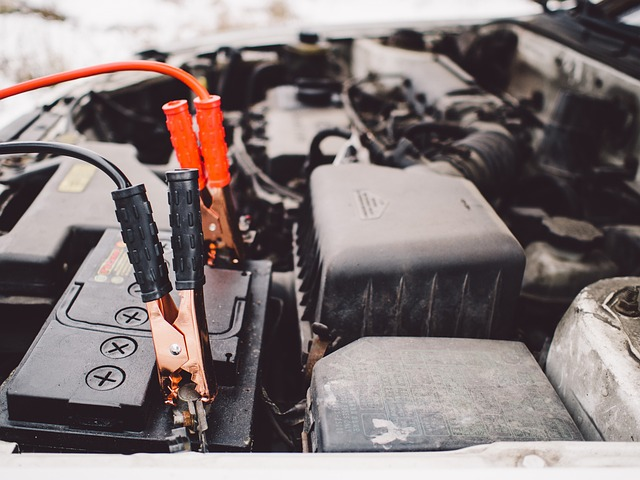When connecting the positive terminal of a car battery sparks indicate a short circuit warning. To prevent further damage, stop immediately and troubleshoot the issue.
Sparks are a common occurrence when connecting batteries and inverters, but understanding why they happen is crucial for safety and maintenance. By following simple steps like covering your wrench with electrical tape or disconnecting the negative terminal first, you can reduce the risk of sparks and ensure smooth battery connections.
Ensuring a secure and safe connection will not only prolong the life of your battery but also safeguard against potential accidents or malfunctions. Let’s delve deeper into the reasons behind sparking incidents when connecting the positive terminal of a car battery and explore effective ways to prevent them.
Why Do Car Battery Terminals Spark?
Battery sparking when connecting the positive terminal can be a concerning phenomenon for car owners. Understanding the reasons behind these sparks and their potential dangers is crucial for ensuring safe car battery maintenance.
Understanding The Phenomenon Of Sparking
When connecting the positive terminal of a car battery, sparks may occur due to the electrical currents and metal-to-metal contact during the process. These sparks are a result of the electrical energy present in the battery seeking a path to balance the charge.
Reasons Behind The Sparks
The presence of residual charge, corrosion, or loose connections on the terminals can lead to sparking when connecting the positive terminal. Additionally, rapid energy transfer during the connection process can also generate sparks.
Potential Dangers Of Sparking
Sparking at the battery terminals can pose several hazards, including the risk of fire, personal injury, and damage to the vehicle’s electrical system. Additionally, the presence of sparks could indicate an underlying issue with the battery or electrical components, calling for immediate attention.
Preventing Sparking During Battery Connection
When connecting the positive terminal of a car battery, prevent sparking by disconnecting the negative terminal first. Cover the wrench with electrical tape before handling the terminals to avoid any potential short circuits. Properly disconnecting the terminals can prevent sparks and potential damage.
Disconnecting The Negative Terminal First
When connecting a car battery, always disconnect the negative terminal first to reduce the risk of sparking.
Covering Tools With Electrical Tape
Cover your tools, like a wrench, with electrical tape to prevent accidental sparks when working near the battery.
Using Anti-corrosion Spray
Spray anti-corrosion solution on the battery terminals to reduce oxidation and the chances of sparking.
Specific Cases: Sparks With Inverter And Battery Connection
When connecting the positive terminal of a car battery, sparks can occur. This is usually due to a short circuit, indicating a warning. It is recommended to disconnect the negative terminal first to prevent this and mitigate further damage. This is essential for preventing sparking and potential hazards.
Introduction To Sparking With Inverters
Sparks often occur when connecting inverters and batteries due to a short circuit.
Methods To Prevent Sparking
- Ensure the inverter is turned off before connecting it to the battery.
- Use insulated tools to minimize the risk of sparks.
- Connect the negative terminal first when attaching the inverter.
- Avoid connecting or disconnecting the inverter and battery in wet conditions.
Conclusion
Sparking when connecting an inverter and a battery can be prevented by following simple precautions and proper connection procedures.
Common Questions And Concerns
When it comes to car battery maintenance, there are often concerns regarding sparks that may occur when connecting the positive terminal. Understanding the reasons behind these sparks and the best practices for handling such situations is essential for ensuring safety and preventing damage to the vehicle’s electrical system.
Why Is The Positive Terminal Sparking?
Sparks on the positive terminal of a car battery can occur due to the accumulation of residual charge. This phenomenon is typically observed when the battery is not properly maintained or when the connections are not securely fastened. It’s important to address this issue promptly to prevent any potential damage to the battery or electrical components of the vehicle.
What Happens If You Disconnect The Positive Terminal First?
Disconnecting the positive terminal first can lead to potential hazards, including the risk of sparks and electrical short circuits. This sequence can also disrupt the power distribution within the vehicle, causing damage to sensitive electronics and control units. It’s crucial to follow recommended procedures for disconnecting and connecting the battery terminals to avoid any adverse effects.
Should A Car Battery Spark When Being Connected?
Sparks when connecting a car battery can indicate underlying issues such as loose connections or a faulty battery. While minor spark occurrences may be normal due to the flow of current, excessive sparking could signify an underlying problem that requires attention. Regular maintenance and proper handling of battery terminals are key to minimizing the occurrence of sparks during the connection process.
Understanding The Physics Behind Sparking
When connecting the positive terminal of a car battery, it’s not uncommon to see sparks flying. While this may seem alarming, it’s important to understand the physics behind this phenomenon. By delving into the concepts of induction, the role of capacitors, and the explanation of arcing, we can gain a better understanding of why sparks occur during this process.
Induction And Change In Magnetic Field
One of the key factors that contribute to sparking when connecting the positive terminal of a car battery is induction. Induction occurs when there is a change in the magnetic field. In this case, when the positive terminal of the battery comes into contact with another electrical component, such as an inductor, the connection causes a change in the magnetic field surrounding the wire.
This change in the magnetic field triggers a counter-current flow known as induction. Nature abhors a change in flux, and this counter-current flow is induced to oppose the change. It is this counter-current flow that ultimately results in the sparks that we see when connecting the positive terminal.
Role Of Capacitors
Another important element in understanding sparking is the role of capacitors. Capacitors are electrical components that store and release electrical energy. When connecting the positive terminal of a car battery, capacitors can play a significant role in causing sparks.
As the positive terminal is connected, the capacitors in the circuit start to charge. This charging process leads to a sudden surge of electrical energy, which in turn creates sparks. These sparks occur as the electrical energy is released, causing a momentary discharge between the positive terminal and the component it is connected to.
Explanation Of Arcing
The phenomenon of arcing is also responsible for the sparks we see when connecting the positive terminal of a car battery. Arcing happens when there is a breakdown in the electrical current due to the presence of air or other insulating materials. This breakdown of the current leads to the formation of a visible electrical discharge in the form of sparks.
When connecting the positive terminal, any tiny gaps or imperfections in the connection can cause arcing. These imperfections, coupled with the high electrical energy present in the circuit, result in the generation of sparks. These sparks act as a warning sign, indicating a potential short circuit or improper connection.
In conclusion, the sparking that occurs when connecting the positive terminal of a car battery is a result of induction, the role of capacitors, and the phenomenon of arcing. Understanding the physics behind this process allows us to take the necessary precautions and ensure a safe and accurate connection of the battery.

Credit: www.stonemountainvw.com
Addressing Sparking In Different Scenarios
When connecting the positive terminal of a car battery, sparks may occur due to a short circuit. It is important to stop and avoid further damage if sparks are observed, as they indicate a potential issue. Disconnecting the positive cable first can lead to sparks and damage to the battery.
Sparks During Battery Change
During a battery change, it’s not uncommon to observe sparks when connecting the positive terminal. These sparks are typically caused by the electrical current flowing through the circuit, which can create a small arc between the battery post and the terminal clamp. While sparks may seem concerning, they are often harmless and do not indicate a serious issue.
To minimize the risk of sparks during a battery change, it’s recommended to follow these steps:
- Start by turning off the engine and ensuring all electrical devices are switched off.
- Wear protective gloves and eye goggles to prevent any potential injury.
- Begin by disconnecting the negative (black) battery cable first using a wrench or socket.
- Once the negative cable has been disconnected, proceed to remove the positive (red) battery cable.
- When connecting the new battery, be sure to connect the positive cable first, followed by the negative cable.
Battery Terminal Sparks While Trying To Start
If you encounter sparks at the battery terminals while attempting to start your vehicle, it could indicate a poor connection or a discharged battery. In this scenario, the sparks are typically caused by the electrical current flowing through the connection point, attempting to bridge the gap between the terminal and the battery post.
To address this issue:
- Check the battery terminals for any corrosion or debris. If present, clean the terminals using a wire brush to ensure a solid connection.
- Tighten the terminal clamps to ensure a secure fit on the battery posts.
- If the battery is discharged, jump-start the vehicle or use a battery charger to recharge the battery.
Negative Battery Cable Sparking After Starter Replacement
If you notice sparks at the negative battery cable after replacing the starter, it could indicate a faulty connection or a short circuit in the electrical system. In this case, it’s important to address the issue promptly to prevent further damage.
To resolve this problem:
- Check the negative battery cable for any signs of damage or wear. Replace the cable if necessary.
- Ensure that the cable is securely connected to both the battery post and the starter terminal.
- If the issue persists, consult a professional mechanic to diagnose and repair any underlying electrical problems.
Tips For Safe Battery Connection
When connecting the car battery, it’s essential to prioritize safety. Following best practices can prevent accidents and damage. Here are some crucial tips to ensure a safe battery connection.
Properly Maintaining Battery Terminals
Regularly inspect and clean the battery terminals to remove any corrosion or build-up. Use a terminal brush or baking soda solution to clean the terminals and ensure a secure connection.
Using Insulated Tools
When working on the battery, always use insulated tools to prevent accidental sparks or short circuits. Insulated wrenches and screwdrivers can significantly reduce the risk of electrical accidents.
Seeking Professional Assistance When Unsure
If you are unsure about any aspect of the battery connection process or encounter any difficulties, it’s always best to seek professional assistance. Professional mechanics can provide expert guidance and ensure a safe and secure battery connection.

Credit: www.reddit.com
Conclusion: Don’t Ignore The Sparks
Sparks during the connection process indicate a potential problem with the circuit. Ignoring these sparks can lead to further damage and safety hazards.
Properly disconnecting the car battery is crucial to prevent sparks and ensure a safe operation. Always follow the correct sequence when connecting and disconnecting the battery terminals to avoid sparks.
By paying attention to the warning signs of sparks and disconnecting the battery properly, you can extend the lifespan of your car battery and maintain a safe environment for yourself and others.
:max_bytes(150000):strip_icc()/114513497-1-56a104ad5f9b58eba4b6b116-3038034d2e01464f8e3934521f169762.jpg)
Credit: www.lifewire.com
Frequently Asked Questions On Car Battery Sparks When Connecting Positive
Why Is The Positive Terminal On My Battery Sparking?
Sparks on the positive terminal of a battery indicate a short circuit. Stop what you’re doing to avoid further damage. Disconnect the negative cable before the positive to prevent sparks and battery damage.
How Do You Hook Up A Battery Without Sparking It?
To hook up a battery without sparking, connect the positive terminal first, then the negative. Use electrical tape to cover the wrench and prevent short circuits. Be sure to disconnect the negative terminal first when removing the battery. This method helps avoid sparking and potential damage.
Why Does Battery Charger Spark When Connecting?
Sparks on battery charger connection indicate a short circuit. It’s a warning to stop and prevent damage.
What Happens If You Disconnect The Positive Terminal First While?
Disconnecting the positive terminal first can cause sparks, indicating a short circuit. Always remove the negative terminal first.
Faq 1: Why Does A Negative Battery Cable Spark When Connecting?
The sparks occur due to a short circuit, indicating potential damage. Disconnecting the positive cable first can help avoid this.
Conclusion
To prevent sparks when connecting the positive terminal of a car battery, always disconnect the negative terminal first. These sparks signal a potential short circuit and serve as a warning to stop the process immediately. By following the correct procedure, you can avoid damage to the battery and ensure a safe disconnect or connection.


